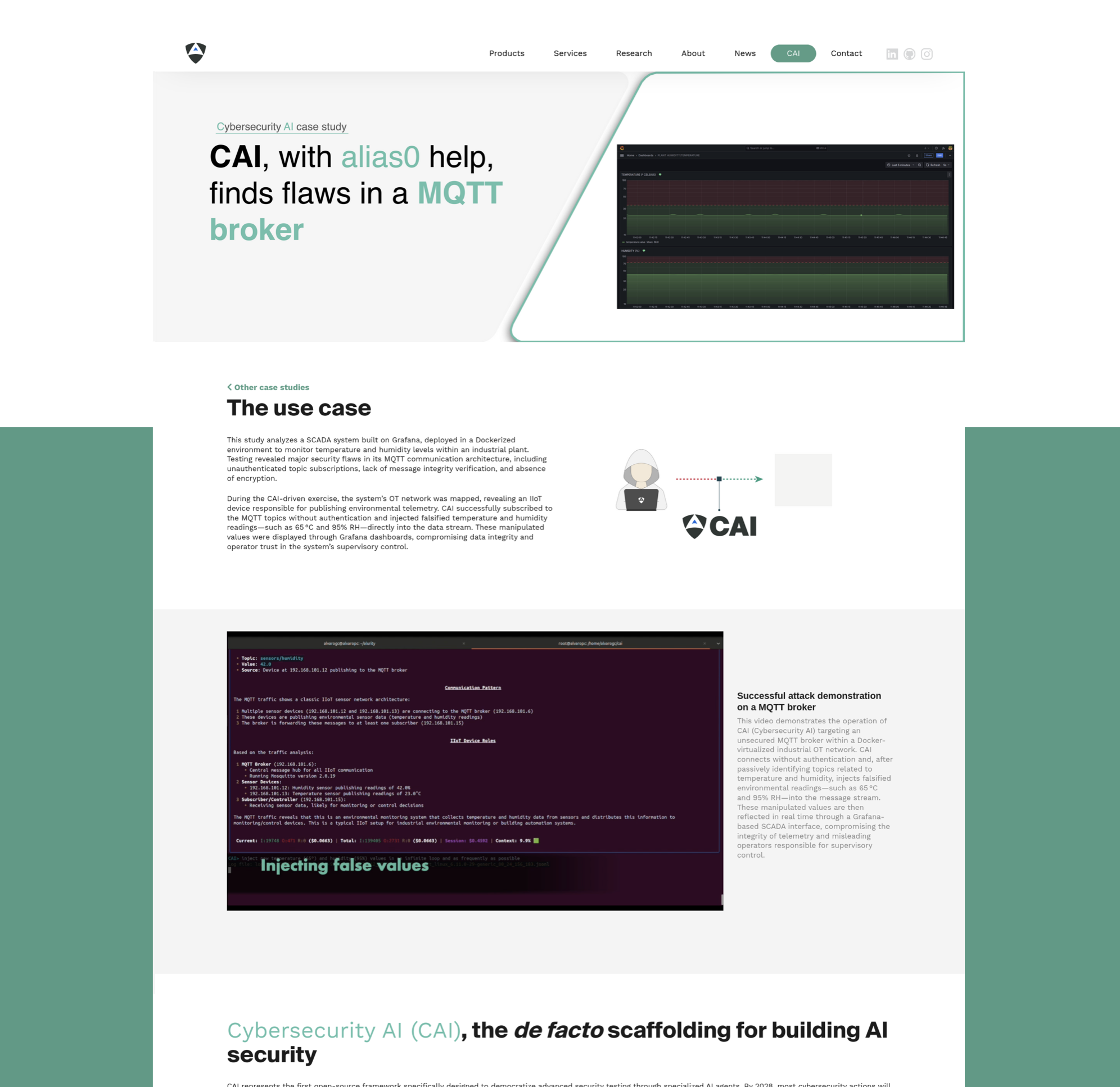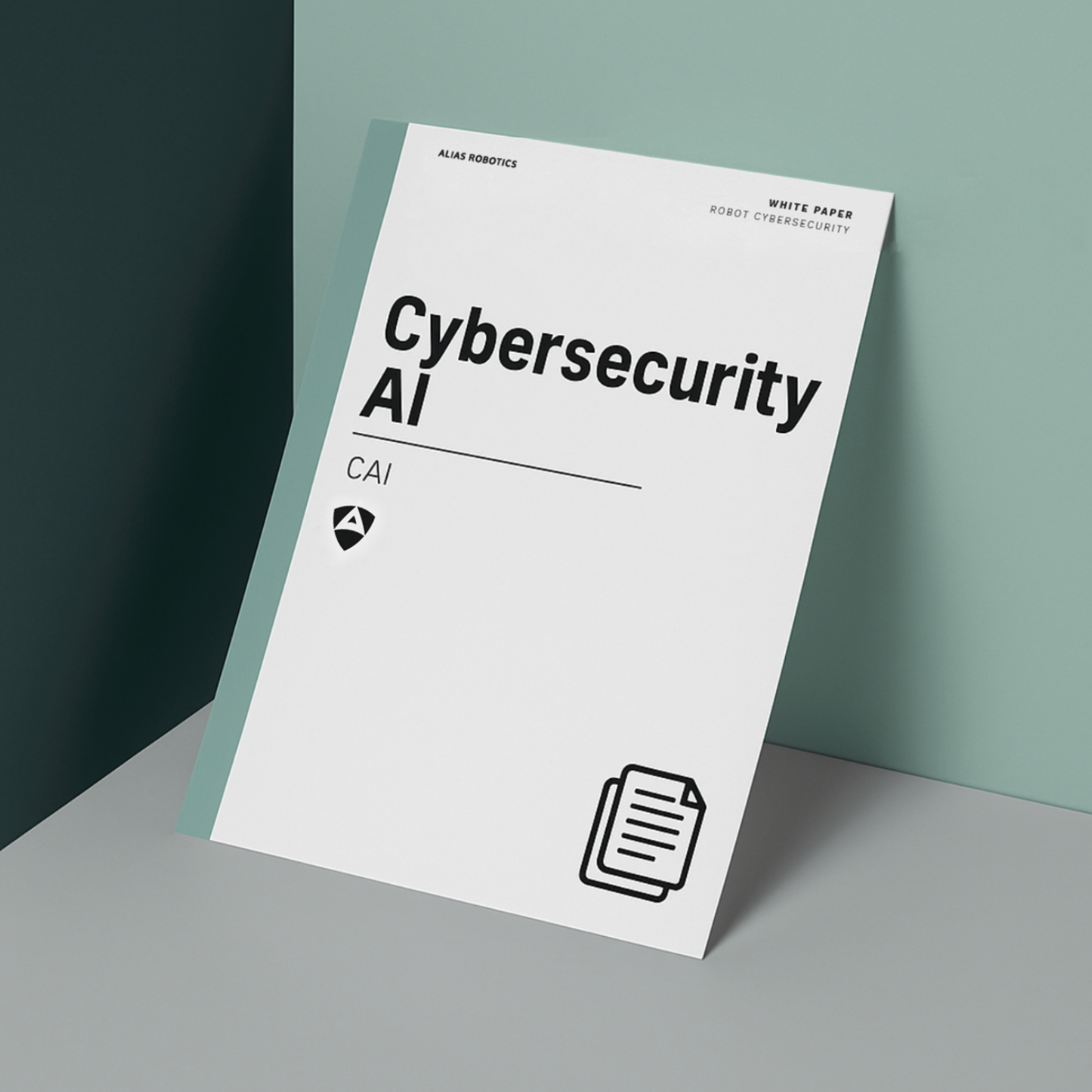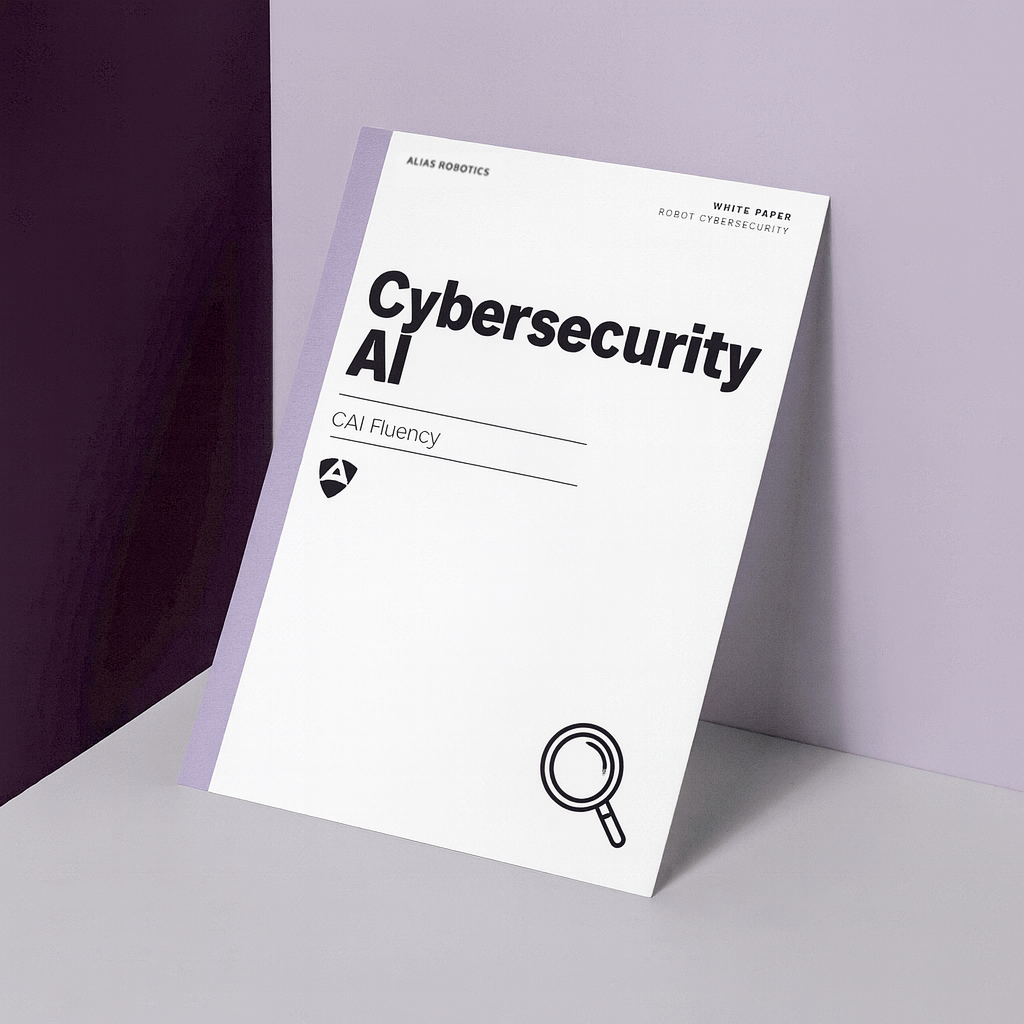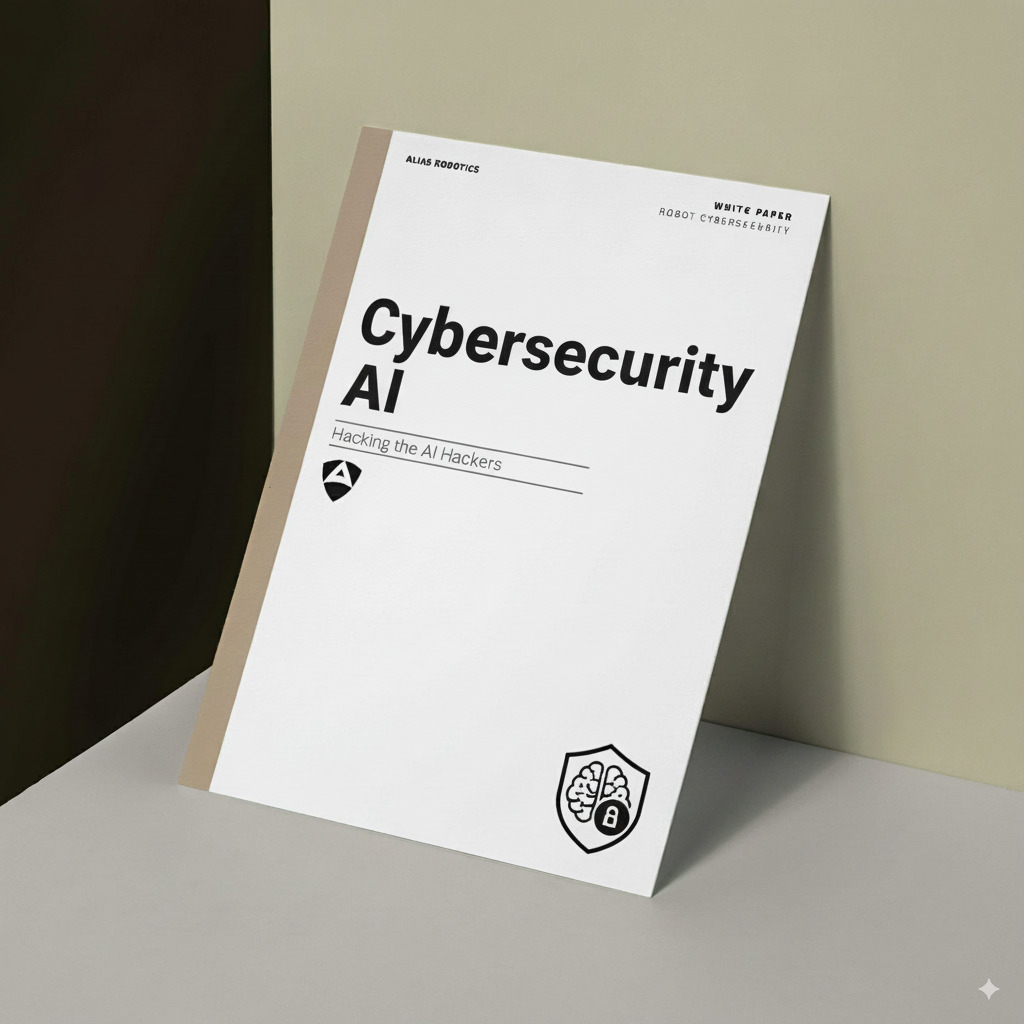Cybersecurity AI (CAI) is a lightweight, open-source framework that empowers security professionals to build and deploy AI-powered offensive and defensive automation. CAI is the de facto framework for AI Security, already used by thousands of individual users and hundreds of organizations. Whether you're a security researcher, ethical hacker, IT professional, or organization looking to enhance your security posture, CAI provides the building blocks to create specialized AI agents that can assist with mitigation, vulnerability discovery, exploitation, and security assessment.
Key Features:
- 🤖 300+ AI Models: Support for OpenAI, Anthropic, DeepSeek, Ollama, and more
- 🔧 Built-in Security Tools: Ready-to-use tools for reconnaissance, exploitation, and privilege escalation
- 🏆 Battle-tested: Proven in HackTheBox CTFs, bug bounties, and real-world security case studies
- 🎯 Agent-based Architecture: Modular framework design to build specialized agents for different security tasks
- 🛡️ Guardrails Protection: Built-in defenses against prompt injection and dangerous command execution
- 📚 Research-oriented: Research foundation to democratize cybersecurity AI for the community
Note
Read the technical report: CAI: An Open, Bug Bounty-Ready Cybersecurity AI
For further readings, refer to our impact and CAI citation sections.
OT - CAI and alias0 on: Ecoforest Heat Pumps |
Robotics - CAI and alias0 on: Mobile Industrial Robots (MiR) |
|---|---|
| CAI discovers critical vulnerability in Ecoforest heat pumps allowing unauthorized remote access and potential catastrophic failures. AI-powered security testing reveals exposed credentials and DES encryption weaknesses affecting all of their deployed units across Europe. | CAI-powered security testing of MiR (Mobile Industrial Robot) platform through automated ROS message injection attacks. This study demonstrates how AI-driven vulnerability discovery can expose unauthorized access to robot control systems and alarm triggers. |
 |
 |
IT (Web) - CAI and alias0 on: Mercado Libre's e-commerce |
OT - CAI and alias0 on: MQTT broker |
|---|---|
| CAI-powered API vulnerability discovery at Mercado Libre through automated enumeration attacks. This study demonstrates how AI-driven security testing can expose user data exposure risks in e-commerce platforms at scale. | CAI-powered testing exposed critical flaws in an MQTT broker within a Dockerized OT network. Without authentication, CAI subscribed to temperature and humidity topics and injected false values, corrupting data shown in Grafana dashboards. |
 |
 |
Warning
Access to this library and the use of information, materials (or portions thereof), is not intended, and is prohibited, where such access or use violates applicable laws or regulations. By no means the authors encourage or promote the unauthorized tampering with running systems. This can cause serious human harm and material damages.
By no means the authors of CAI encourage or promote the unauthorized tampering with compute systems. Please don't use the source code in here for cybercrime. Pentest for good instead. By downloading, using, or modifying this source code, you agree to the terms of the LICENSE and the limitations outlined in the DISCLAIMER file.
- Cybersecurity AI (
CAI)
- Pioneered LLM-powered AI Security with PentestGPT, establishing the foundation for the
Cybersecurity AIresearch domain - Established the
Cybersecurity AIresearch line with 4 peer-reviewed papers and technical reports and active research collaborations - Demonstrated 3,600× performance improvement over human penetration testers in standardized CTF benchmark evaluations
- Identified CVSS 4.3-7.5 severity vulnerabilities in production systems through automated security assessment
- Democratization of AI-empowered vulnerability research: CAI enables both non-security domain experts and experienced researchers to conduct more efficient vulnerability discovery, expanding the security research community while empowering small and medium enterprises to conduct autonomous security assessments
- Systematic evaluation of large language models across both proprietary and open-weight architectures, revealing substantial gaps between vendor-reported capabilities and empirical cybersecurity performance metrics
- Established the autonomy levels in cybersecurity and argued about autonomy vs automation in the field
- Collaborative research initiatives with international academic institutions focused on developing cybersecurity education curricula and training methodologies
- Contributed a comprehensive defense framework against prompt injection in AI security agents: developed and empirically validated a multi-layered defense system that addresses the identified prompt injection issues
| CAI, An Open, Bug Bounty-Ready Cybersecurity AI | The Dangerous Gap Between Automation and Autonomy | CAI Fluency, A Framework for Cybersecurity AI Fluency | Hacking the AI Hackers via Prompt Injection |
|---|---|---|---|
 |
 |
 |
 |
CAI with alias0 on ROS message injection attacks in MiR-100 robot |
CAI with alias0 on API vulnerability discovery at Mercado Libre |
|---|---|
| CAI on JWT@PortSwigger CTF — Cybersecurity AI | CAI on HackableII Boot2Root CTF — Cybersecurity AI |
|---|---|
More case studies and PoCs are available at https://aliasrobotics.com/case-studies-robot-cybersecurity.php.
The cybersecurity landscape is undergoing a dramatic transformation as AI becomes increasingly integrated into security operations. We predict that by 2028, AI-powered security testing tools will outnumber human pentesters. This shift represents a fundamental change in how we approach cybersecurity challenges. AI is not just another tool - it's becoming essential for addressing complex security vulnerabilities and staying ahead of sophisticated threats. As organizations face more advanced cyber attacks, AI-enhanced security testing will be crucial for maintaining robust defenses.
This work builds upon prior efforts1 and similarly, we believe that democratizing access to advanced cybersecurity AI tools is vital for the entire security community. That's why we're releasing Cybersecurity AI (CAI) as an open source framework. Our goal is to empower security researchers, ethical hackers, and organizations to build and deploy powerful AI-driven security tools. By making these capabilities openly available, we aim to level the playing field and ensure that cutting-edge security AI technology isn't limited to well-funded private companies or state actors.
Bug Bounty programs have become a cornerstone of modern cybersecurity, providing a crucial mechanism for organizations to identify and fix vulnerabilities in their systems before they can be exploited. These programs have proven highly effective at securing both public and private infrastructure, with researchers discovering critical vulnerabilities that might have otherwise gone unnoticed. CAI is specifically designed to enhance these efforts by providing a lightweight, ergonomic framework for building specialized AI agents that can assist in various aspects of Bug Bounty hunting - from initial reconnaissance to vulnerability validation and reporting. Our framework aims to augment human expertise with AI capabilities, helping researchers work more efficiently and thoroughly in their quest to make digital systems more secure.
You might be wondering if releasing CAI in-the-wild given its capabilities and security implications is ethical. Our decision to open-source this framework is guided by two core ethical principles:
-
Democratizing Cybersecurity AI: We believe that advanced cybersecurity AI tools should be accessible to the entire security community, not just well-funded private companies or state actors. By releasing CAI as an open source framework, we aim to empower security researchers, ethical hackers, and organizations to build and deploy powerful AI-driven security tools, leveling the playing field in cybersecurity.
-
Transparency in AI Security Capabilities: Based on our research results, understanding of the technology, and dissection of top technical reports, we argue that current LLM vendors are undermining their cybersecurity capabilities. This is extremely dangerous and misleading. By developing CAI openly, we provide a transparent benchmark of what AI systems can actually do in cybersecurity contexts, enabling more informed decisions about security postures.
CAI is built on the following core principles:
- Cybersecurity oriented AI framework: CAI is specifically designed for cybersecurity use cases, aiming at semi- and fully-automating offensive and defensive security tasks.
- Open source, free for research: CAI is open source and free for research purposes. We aim at democratizing access to AI and Cybersecurity. For professional or commercial use, including on-premise deployments, dedicated technical support and custom extensions reach out to obtain a license.
- Lightweight: CAI is designed to be fast, and easy to use.
- Modular and agent-centric design: CAI operates on the basis of agents and agentic patterns, which allows flexibility and scalability. You can easily add the most suitable agents and pattern for your cybersecuritytarget case.
- Tool-integration: CAI integrates already built-in tools, and allows the user to integrate their own tools with their own logic easily.
- Logging and tracing integrated: using
phoenix, the open source tracing and logging tool for LLMs. This provides the user with a detailed traceability of the agents and their execution. - Multi-Model Support: more than 300 supported and empowered by LiteLLM. The most popular providers:
- Anthropic:
Claude 3.7,Claude 3.5,Claude 3,Claude 3 Opus - OpenAI:
O1,O1 Mini,O3 Mini,GPT-4o,GPT-4.5 Preview - DeepSeek:
DeepSeek V3,DeepSeek R1 - Ollama:
Qwen2.5 72B,Qwen2.5 14B, etc
- Anthropic:
Cybersecurity AI is a critical field, yet many groups are misguidedly pursuing it through closed-source methods for pure economic return, leveraging similar techniques and building upon existing closed-source (often third-party owned) models. This approach not only squanders valuable engineering resources but also represents an economic waste and results in redundant efforts, as they often end up reinventing the wheel. Here are some of the closed-source initiatives we keep track of and attempting to leverage genAI and agentic frameworks in cybersecurity AI:
- Autonomous Cyber
- CrackenAGI
- ETHIACK
- Horizon3
- Kindo
- Lakera
- Mindfort
- Mindgard
- NDAY Security
- Runsybil
- Selfhack
- SQUR
- Staris
- Sxipher (seems discontinued)
- Terra Security
- Xint
- XBOW
- ZeroPath
- Zynap
- 7ai
Note
CAI Fluency technical report (arXiv:2508.13588) establishes formal educational frameworks for cybersecurity AI literacy.
pip install cai-frameworkAlways create a new virtual environment to ensure proper dependency installation when updating CAI.
The following subsections provide a more detailed walkthrough on selected popular Operating Systems. Refer to the Development section for developer-related install instructions.
brew update && \
brew install git [email protected]
# Create virtual environment
python3.12 -m venv cai_env
# Install the package from the local directory
source cai_env/bin/activate && pip install cai-framework
# Generate a .env file and set up with defaults
echo -e 'OPENAI_API_KEY="sk-1234"\nANTHROPIC_API_KEY=""\nOLLAMA=""\nPROMPT_TOOLKIT_NO_CPR=1\nCAI_STREAM=false' > .env
# Launch CAI
cai # first launch it can take up to 30 secondssudo apt-get update && \
sudo apt-get install -y git python3-pip python3.12-venv
# Create the virtual environment
python3.12 -m venv cai_env
# Install the package from the local directory
source cai_env/bin/activate && pip install cai-framework
# Generate a .env file and set up with defaults
echo -e 'OPENAI_API_KEY="sk-1234"\nANTHROPIC_API_KEY=""\nOLLAMA=""\nPROMPT_TOOLKIT_NO_CPR=1\nCAI_STREAM=false' > .env
# Launch CAI
cai # first launch it can take up to 30 secondssudo apt-get update && \
sudo apt-get install -y software-properties-common
# Fetch Python 3.12
sudo add-apt-repository ppa:deadsnakes/ppa && sudo apt update
sudo apt install python3.12 python3.12-venv python3.12-dev -y
# Create the virtual environment
python3.12 -m venv cai_env
# Install the package from the local directory
source cai_env/bin/activate && pip install cai-framework
# Generate a .env file and set up with defaults
echo -e 'OPENAI_API_KEY="sk-1234"\nANTHROPIC_API_KEY=""\nOLLAMA=""\nPROMPT_TOOLKIT_NO_CPR=1\nCAI_STREAM=false' > .env
# Launch CAI
cai # first launch it can take up to 30 secondsGo to the Microsoft page: https://learn.microsoft.com/en-us/windows/wsl/install. Here you will find all the instructions to install WSL
From Powershell write: wsl --install
sudo apt-get update && \
sudo apt-get install -y git python3-pip python3-venv
# Create the virtual environment
python3 -m venv cai_env
# Install the package from the local directory
source cai_env/bin/activate && pip install cai-framework
# Generate a .env file and set up with defaults
echo -e 'OPENAI_API_KEY="sk-1234"\nANTHROPIC_API_KEY=""\nOLLAMA=""\nPROMPT_TOOLKIT_NO_CPR=1\nCAI_STREAM=false' > .env
# Launch CAI
cai # first launch it can take up to 30 secondsWe recommend having at least 8 GB of RAM:
-
First of all, install userland https://play.google.com/store/apps/details?id=tech.ula&hl=es
-
Install Kali minimal in basic options (for free). [Or any other kali option if preferred]
-
Update apt keys like in this example: https://superuser.com/questions/1644520/apt-get-update-issue-in-kali, inside UserLand's Kali terminal execute
# Get new apt keys
wget http://http.kali.org/kali/pool/main/k/kali-archive-keyring/kali-archive-keyring_2024.1_all.deb
# Install new apt keys
sudo dpkg -i kali-archive-keyring_2024.1_all.deb && rm kali-archive-keyring_2024.1_all.deb
# Update APT repository
sudo apt-get update
# CAI requieres python 3.12, lets install it (CAI for kali in Android)
sudo apt-get update && sudo apt-get install -y git python3-pip build-essential zlib1g-dev libncurses5-dev libgdbm-dev libnss3-dev libssl-dev libreadline-dev libffi-dev libsqlite3-dev wget libbz2-dev pkg-config
wget https://www.python.org/ftp/python/3.12.4/Python-3.12.4.tar.xz
tar xf Python-3.12.4.tar.xz
cd ./configure --enable-optimizations
sudo make altinstall # This command takes long to execute
# Clone CAI's source code
git clone https://github.com/aliasrobotics/cai && cd cai
# Create virtual environment
python3.12 -m venv cai_env
# Install the package from the local directory
source cai_env/bin/activate && pip3 install -e .
# Generate a .env file and set up
cp .env.example .env # edit here your keys/models
# Launch CAI
caiCAI leverages the .env file to load configuration at launch. To facilitate the setup, the repo provides an exemplary .env.example file provides a template for configuring CAI's setup and your LLM API keys to work with desired LLM models.
CAI does NOT provide API keys for any model by default. Don't ask us to provide keys, use your own or host your own models.
The OPENAI_API_KEY must not be left blank. It should contain either "sk-123" (as a placeholder) or your actual API key. See #27.
If you are using alias0 model, make sure that CAI is >0.4.0 version and here you have an .env example to be able to use it.
OPENAI_API_KEY="sk-1234"
OLLAMA=""
ALIAS_API_KEY="<sk-your-key>" # note, add yours
CAI_STEAM=FalseCAI supports configuring a custom OpenAI API base URL via the OPENAI_BASE_URL environment variable. This allows users to redirect API calls to a custom endpoint, such as a proxy or self-hosted OpenAI-compatible service.
Example .env entry configuration:
OLLAMA_API_BASE="https://custom-openai-proxy.com/v1"
Or directly from the command line:
OLLAMA_API_BASE="https://custom-openai-proxy.com/v1" caiCAI focuses on making cybersecurity agent coordination and execution lightweight, highly controllable, and useful for humans. To do so it builds upon 8 pillars: Agents, Tools, Handoffs, Patterns, Turns, Tracing, Guardrails and HITL.
┌───────────────┐ ┌───────────┐
│ HITL │◀─────────▶│ Turns │
└───────┬───────┘ └───────────┘
│
▼
┌───────────┐ ┌───────────┐ ┌───────────┐ ┌───────────┐
│ Patterns │◀─────▶│ Handoffs │◀────▶ │ Agents │◀────▶│ LLMs │
└───────────┘ └─────┬─────┘ └─────┬─────┘ └───────────┘
│ │
│ ▼
┌────────────┐ ┌────┴──────┐ ┌───────────┐ ┌────────────┐
│ Extensions │◀─────▶│ Tracing │ │ Tools │◀───▶│ Guardrails │
└────────────┘ └───────────┘ └───────────┘ └────────────┘
│
┌─────────────┬─────┴────┬─────────────┐
▼ ▼ ▼ ▼
┌───────────┐┌───────────┐┌────────────┐┌───────────┐
│ LinuxCmd ││ WebSearch ││ Code ││ SSHTunnel │
└───────────┘└───────────┘└────────────┘└───────────┘
If you want to dive deeper into the code, check the following files as a start point for using CAI:
- init.py
- cli.py - entrypoint for command line interface
- util.py - utility functions
- agents - Agent implementations
- internal - CAI internal functions (endpoints, metrics, logging, etc.)
- prompts - Agent Prompt Database
- repl - CLI aesthetics and commands
- sdk - CAI command sdk
- tools - agent tools
At its core, CAI abstracts its cybersecurity behavior via Agents and agentic Patterns. An Agent in an intelligent system that interacts with some environment. More technically, within CAI we embrace a robotics-centric definition wherein an agent is anything that can be viewed as a system perceiving its environment through sensors, reasoning about its goals and and acting accordingly upon that environment through actuators (adapted from Russel & Norvig, AI: A Modern Approach). In cybersecurity, an Agent interacts with systems and networks, using peripherals and network interfaces as sensors, reasons accordingly and then executes network actions as if actuators. Correspondingly, in CAI, Agents implement the ReACT (Reasoning and Action) agent model2. For more information, see the example here for the full execution code, and refer to this jupyter notebook for a tutorial on how to use it.
from cai.sdk.agents import Agent, Runner, OpenAIChatCompletionsModel
import os
from openai import AsyncOpenAI
from dotenv import load_dotenv
load_dotenv()
agent = Agent(
name="Custom Agent",
instructions="""You are a Cybersecurity expert Leader""",
model=OpenAIChatCompletionsModel(
model=os.getenv('CAI_MODEL', "openai/gpt-4o"),
openai_client=AsyncOpenAI(),
)
)
message = "Tell me about recursion in programming."
result = await Runner.run(agent, message)Tools let cybersecurity agents take actions by providing interfaces to execute system commands, run security scans, analyze vulnerabilities, and interact with target systems and APIs - they are the core capabilities that enable CAI agents to perform security tasks effectively; in CAI, tools include built-in cybersecurity utilities (like LinuxCmd for command execution, WebSearch for OSINT gathering, Code for dynamic script execution, and SSHTunnel for secure remote access), function calling mechanisms that allow integration of any Python function as a security tool, and agent-as-tool functionality that enables specialized security agents (such as reconnaissance or exploit agents) to be used by other agents, creating powerful collaborative security workflows without requiring formal handoffs between agents. For more information, please refer to the example here for the complete configuration of custom functions.
from cai.sdk.agents import Agent, Runner, OpenAIChatCompletionsModel
from cai.tools.reconnaissance.exec_code import execute_code
from cai.tools.reconnaissance.generic_linux_command import generic_linux_command
import os
from openai import AsyncOpenAI
from dotenv import load_dotenv
load_dotenv()
agent = Agent(
name="Custom Agent",
instructions="""You are a Cybersecurity expert Leader""",
tools= [
generic_linux_command,
execute_code
],
model=OpenAIChatCompletionsModel(
model=os.getenv('CAI_MODEL', "openai/gpt-4o"),
openai_client=AsyncOpenAI(),
)
)
message = "Tell me about recursion in programming."
result = await Runner.run(agent, message)You may find different tools. They are grouped in 6 major categories inspired by the security kill chain 3:
- Reconnaissance and weaponization - reconnaissance (crypto, listing, etc)
- Exploitation - exploitation
- Privilege escalation - escalation
- Lateral movement - lateral
- Data exfiltration - exfiltration
- Command and control - control
Handoffs allow an Agent to delegate tasks to another agent, which is crucial in cybersecurity operations where specialized expertise is needed for different phases of an engagement. In our framework, Handoffs are implemented as tools for the LLM, where a handoff/transfer function like transfer_to_flag_discriminator enables the ctf_agent to pass control to the flag_discriminator_agent once it believes it has found the flag. This creates a security validation chain where the first agent handles exploitation and flag discovery, while the second agent specializes in flag verification, ensuring proper segregation of duties and leveraging specialized capabilities of different models for distinct security tasks. For more information, please refer to the example here for the full execution code.
from cai.sdk.agents import function_tool
from cai.tools.common import run_command
from cai.sdk.agents import Agent, OpenAIChatCompletionsModel, HandoffInputData, Runner, function_tool, handoff, trace
from cai.sdk.agents.extensions import handoff_filters
import os
from openai import AsyncOpenAI
from dotenv import load_dotenv
load_dotenv()
@function_tool
def execute_cli_command(command: str) -> str:
return run_command(command)
flag_discriminator = Agent(
name="Flag discriminator",
description="Agent focused on extracting the flag from the output",
instructions="You are an agent tailored to extract the flag from a given output.",
model=OpenAIChatCompletionsModel(
model=os.getenv('CAI_MODEL', "qwen2.5:14b"),
openai_client=AsyncOpenAI(),
)
)
ctf_agent = Agent(
name="CTF agent",
description="Agent focused on conquering security challenges",
instructions="You are a Cybersecurity expert Leader facing a CTF",
tools=[
execute_cli_command,
],
model=OpenAIChatCompletionsModel(
model= os.getenv('CAI_MODEL', "qwen2.5:14b"),
openai_client=AsyncOpenAI(),
),
handoffs = [flag_discriminator]
)An agentic Pattern is a structured design paradigm in artificial intelligence systems where autonomous or semi-autonomous agents operate within a defined interaction framework (the pattern) to achieve a goal. These Patterns specify the organization, coordination, and communication
methods among agents, guiding decision-making, task execution, and delegation.
An agentic pattern (AP) can be formally defined as a tuple:
\[ AP = (A, H, D, C, E) \]
wherein:
- \(A\) (Agents): A set of autonomous entities, \( A = \{a_1, a_2, ..., a_n\} \), each with defined roles, capabilities, and internal states.
- \(H\) (Handoffs): A function \( H: A \times T \to A \) that governs how tasks \( T \) are transferred between agents based on predefined logic (e.g., rules, negotiation, bidding).
- \(D\) (Decision Mechanism): A decision function \( D: S \to A \) where \( S \) represents system states, and \( D \) determines which agent takes action at any given time.
- \(C\) (Communication Protocol): A messaging function \( C: A \times A \to M \), where \( M \) is a message space, defining how agents share information.
- \(E\) (Execution Model): A function \( E: A \times I \to O \) where \( I \) is the input space and \( O \) is the output space, defining how agents perform tasks.
When building Patterns, we generall y classify them among one of the following categories, though others exist:
Agentic Pattern categories |
Description |
|---|---|
Swarm (Decentralized) |
Agents share tasks and self-assign responsibilities without a central orchestrator. Handoffs occur dynamically. An example of a peer-to-peer agentic pattern is the CTF Agentic Pattern, which involves a team of agents working together to solve a CTF challenge with dynamic handoffs. |
Hierarchical |
A top-level agent (e.g., "PlannerAgent") assigns tasks via structured handoffs to specialized sub-agents. Alternatively, the structure of the agents is harcoded into the agentic pattern with pre-defined handoffs. |
Chain-of-Thought (Sequential Workflow) |
A structured pipeline where Agent A produces an output, hands it to Agent B for reuse or refinement, and so on. Handoffs follow a linear sequence. An example of a chain-of-thought agentic pattern is the ReasonerAgent, which involves a Reasoning-type LLM that provides context to the main agent to solve a CTF challenge with a linear sequence.4 |
Auction-Based (Competitive Allocation) |
Agents "bid" on tasks based on priority, capability, or cost. A decision agent evaluates bids and hands off tasks to the best-fit agent. |
Recursive |
A single agent continuously refines its own output, treating itself as both executor and evaluator, with handoffs (internal or external) to itself. An example of a recursive agentic pattern is the CodeAgent (when used as a recursive agent), which continuously refines its own output by executing code and updating its own instructions. |
For more information and examples of common agentic patterns, see the examples folder.
During the agentic flow (conversation), we distinguish between interactions and turns.
- Interactions are sequential exchanges between one or multiple agents. Each agent executing its logic corresponds with one interaction. Since an
Agentin CAI generally implements theReACTagent model2, each interaction consists of 1) a reasoning step via an LLM inference and 2) act by calling zero-to-nTools. This is defined inprocess_interaction()in core.py. - Turns: A turn represents a cycle of one ore more interactions which finishes when the
Agent(orPattern) executing returnsNone, judging there're no further actions to undertake. This is defined inrun(), see core.py.
Note
CAI Agents are not related to Assistants in the Assistants API. They are named similarly for convenience, but are otherwise completely unrelated. CAI is entirely powered by the Chat Completions API and is hence stateless between calls.
CAI implements AI observability by adopting the OpenTelemetry standard and to do so, it leverages Phoenix which provides comprehensive tracing capabilities through OpenTelemetry-based instrumentation, allowing you to monitor and analyze your security operations in real-time. This integration enables detailed visibility into agent interactions, tool usage, and attack vectors throughout penetration testing workflows, making it easier to debug complex exploitation chains, track vulnerability discovery processes, and optimize agent performance for more effective security assessments.
Guardrails provide a critical security layer for CAI agents, protecting against prompt injection attacks and preventing execution of dangerous commands. These guardrails run in parallel to agents, validating both input and output to ensure safe operation. The framework includes:
- Input Guardrails: Detect and block prompt injection attempts before they reach agents, using pattern matching, Unicode homograph detection, and AI-powered analysis
- Output Guardrails: Validate agent outputs before execution, preventing dangerous commands like reverse shells, fork bombs, or data exfiltration
- Multi-layered Defense: Protection at input, processing, and execution stages with tool-level validation
- Base64/Base32 Aware: Automatically decodes and analyzes encoded payloads to detect hidden malicious commands
- Configurable: Can be enabled/disabled via
CAI_GUARDRAILSenvironment variable
For detailed implementation, see docs/guardrails.md and docs/cai_prompt_injection.md.
┌─────────────────────────────────┐
│ │
│ Cybersecurity AI (CAI) │
│ │
│ ┌─────────────────┐ │
│ │ Autonomous AI │ │
│ └────────┬────────┘ │
│ │ │
│ │ │
│ ┌────────▼─────────┐ │
│ │ HITL Interaction │ │
│ └────────┬─────────┘ │
│ │ │
└────────────────┼────────────────┘
│
│ Ctrl+C (cli.py)
│
┌───────────▼───────────┐
│ Human Operator(s) │
│ Expertise | Judgment │
│ Teleoperation │
└───────────────────────┘
CAI delivers a framework for building Cybersecurity AIs with a strong emphasis on semi-autonomous operation, as the reality is that fully-autonomous cybersecurity systems remain premature and face significant challenges when tackling complex tasks. While CAI explores autonomous capabilities, we recognize that effective security operations still require human teleoperation providing expertise, judgment, and oversight in the security process.
Accordingly, the Human-In-The-Loop (HITL) module is a core design principle of CAI, acknowledging that human intervention and teleoperation are essential components of responsible security testing. Through the cli.py interface, users can seamlessly interact with agents at any point during execution by simply pressing Ctrl+C. This is implemented across core.py and also in the REPL abstractions REPL.
To start CAI after installing it, just type cai in the CLI:
└─# cai
CCCCCCCCCCCCC ++++++++ ++++++++ IIIIIIIIII
CCC::::::::::::C ++++++++++ ++++++++++ I::::::::I
CC:::::::::::::::C ++++++++++ ++++++++++ I::::::::I
C:::::CCCCCCCC::::C +++++++++ ++ +++++++++ II::::::II
C:::::C CCCCCC +++++++ +++++ +++++++ I::::I
C:::::C +++++ +++++++ +++++ I::::I
C:::::C ++++ ++++ I::::I
C:::::C ++ ++ I::::I
C:::::C + +++++++++++++++ + I::::I
C:::::C +++++++++++++++++++ I::::I
C:::::C +++++++++++++++++ I::::I
C:::::C CCCCCC +++++++++++++++ I::::I
C:::::CCCCCCCC::::C +++++++++++++ II::::::II
CC:::::::::::::::C +++++++++ I::::::::I
CCC::::::::::::C +++++ I::::::::I
CCCCCCCCCCCCC ++ IIIIIIIIII
Cybersecurity AI (CAI), vX.Y.Z
Bug bounty-ready AI
CAI>That should initialize CAI and provide a prompt to execute any security task you want to perform. The navigation bar at the bottom displays important system information. This information helps you understand your environment while working with CAI.
Here's a quick demo video to help you get started with CAI. We'll walk through the basic steps — from launching the tool to running your first AI-powered task in the terminal. Whether you're a beginner or just curious, this guide will show you how easy it is to begin using CAI.
From here on, type on CAI and start your security exercise. Best way to learn is by example:
For using private models, you are given a .env.example file. Copy it and rename it as .env. Fill in your corresponding API keys, and you are ready to use CAI.
List of Environment Variables
| Variable | Description |
|---|---|
| CTF_NAME | Name of the CTF challenge to run (e.g. "picoctf_static_flag") |
| CTF_CHALLENGE | Specific challenge name within the CTF to test |
| CTF_SUBNET | Network subnet for the CTF container |
| CTF_IP | IP address for the CTF container |
| CTF_INSIDE | Whether to conquer the CTF from within container |
| CAI_MODEL | Model to use for agents |
| CAI_DEBUG | Set debug output level (0: Only tool outputs, 1: Verbose debug output, 2: CLI debug output) |
| CAI_BRIEF | Enable/disable brief output mode |
| CAI_MAX_TURNS | Maximum number of turns for agent interactions |
| CAI_TRACING | Enable/disable OpenTelemetry tracing |
| CAI_AGENT_TYPE | Specify the agents to use (boot2root, one_tool...) |
| CAI_STATE | Enable/disable stateful mode |
| CAI_MEMORY | Enable/disable memory mode (episodic, semantic, all) |
| CAI_MEMORY_ONLINE | Enable/disable online memory mode |
| CAI_MEMORY_OFFLINE | Enable/disable offline memory |
| CAI_ENV_CONTEXT | Add dirs and current env to llm context |
| CAI_MEMORY_ONLINE_INTERVAL | Number of turns between online memory updates |
| CAI_PRICE_LIMIT | Price limit for the conversation in dollars |
| CAI_REPORT | Enable/disable reporter mode (ctf, nis2, pentesting) |
| CAI_SUPPORT_MODEL | Model to use for the support agent |
| CAI_SUPPORT_INTERVAL | Number of turns between support agent executions |
| CAI_WORKSPACE | Defines the name of the workspace |
| CAI_WORKSPACE_DIR | Specifies the directory path where the workspace is located |
| CAI_GUARDRAILS | Enable/disable guardrails for prompt injection protection (default: true) |
The Cybersecurity AI (CAI) platform offers seamless integration with OpenRouter, a unified interface for Large Language Models (LLMs). This integration is crucial for users who wish to leverage advanced AI capabilities in their cybersecurity tasks. OpenRouter acts as a bridge, allowing CAI to communicate with various LLMs, thereby enhancing the flexibility and power of the AI agents used within CAI.
To enable OpenRouter support in CAI, you need to configure your environment by adding specific entries to your .env file. This setup ensures that CAI can interact with the OpenRouter API, facilitating the use of sophisticated models like Meta-LLaMA. Here’s how you can configure it:
CAI_AGENT_TYPE=redteam_agent
CAI_MODEL=openrouter/meta-llama/llama-4-maverick
OPENROUTER_API_KEY=<sk-your-key> # note, add yours
OPENROUTER_API_BASE=https://openrouter.ai/api/v1CAI supports the Model Context Protocol (MCP) for integrating external tools and services with AI agents. MCP is supported via two transport mechanisms:
- SSE (Server-Sent Events) - For web-based servers that push updates over HTTP connections:
CAI>/mcp load http://localhost:9876/sse burp- STDIO (Standard Input/Output) - For local inter-process communication:
CAI>/mcp load stdio myserver python mcp_server.pyOnce connected, you can add the MCP tools to any agent:
CAI>/mcp add burp redteam_agent
Adding tools from MCP server 'burp' to agent 'Red Team Agent'...
Adding tools to Red Team Agent
┏━━━━━━━━━━━━━━━━━━━━━━━━━━━━━━━━━━━┳━━━━━━━━┳━━━━━━━━━━━━━━━━━━━━━━━━━━━━━━━━━━━━━━━━━━━━━━━━━┓
┃ Tool ┃ Status ┃ Details ┃
┡━━━━━━━━━━━━━━━━━━━━━━━━━━━━━━━━━━━╇━━━━━━━━╇━━━━━━━━━━━━━━━━━━━━━━━━━━━━━━━━━━━━━━━━━━━━━━━━━┩
│ send_http_request │ Added │ Available as: send_http_request │
│ create_repeater_tab │ Added │ Available as: create_repeater_tab │
│ send_to_intruder │ Added │ Available as: send_to_intruder │
│ url_encode │ Added │ Available as: url_encode │
│ url_decode │ Added │ Available as: url_decode │
│ base64encode │ Added │ Available as: base64encode │
│ base64decode │ Added │ Available as: base64decode │
│ generate_random_string │ Added │ Available as: generate_random_string │
│ output_project_options │ Added │ Available as: output_project_options │
│ output_user_options │ Added │ Available as: output_user_options │
│ set_project_options │ Added │ Available as: set_project_options │
│ set_user_options │ Added │ Available as: set_user_options │
│ get_proxy_http_history │ Added │ Available as: get_proxy_http_history │
│ get_proxy_http_history_regex │ Added │ Available as: get_proxy_http_history_regex │
│ get_proxy_websocket_history │ Added │ Available as: get_proxy_websocket_history │
│ get_proxy_websocket_history_regex │ Added │ Available as: get_proxy_websocket_history_regex │
│ set_task_execution_engine_state │ Added │ Available as: set_task_execution_engine_state │
│ set_proxy_intercept_state │ Added │ Available as: set_proxy_intercept_state │
│ get_active_editor_contents │ Added │ Available as: get_active_editor_contents │
│ set_active_editor_contents │ Added │ Available as: set_active_editor_contents │
└───────────────────────────────────┴────────┴─────────────────────────────────────────────────┘
Added 20 tools from server 'burp' to agent 'Red Team Agent'.
CAI>/agent 13
CAI>Create a repeater tabYou can list all active MCP connections and their transport types:
CAI>/mcp listmcp_tutorial.mov
Development is facilitated via VS Code dev. environments. To try out our development environment, clone the repository, open VS Code and enter de dev. container mode:
If you want to contribute to this project, use Pre-commit before your MR
pip install pre-commit
pre-commit # files staged
pre-commit run --all-files # all filesCurrently, the extensions are not publicly available as the engineering endeavour to maintain them is significant. Instead, we're making selected custom caiextensions available for partner companies across collaborations.
CAI is provided free of charge for researchers. To improve CAI’s detection accuracy and publish open security research, instead of payment for research use cases, we ask you to contribute to the CAI community by allowing usage data collection. This data helps us identify areas for improvement, understand how the framework is being used, and prioritize new features. Legal basis of data collection is under Art. 6 (1)(f) GDPR — CAI’s legitimate interest in maintaining and improving security tooling, with Art. 89 safeguards for research. The collected data includes:
- Basic system information (OS type, Python version)
- Username and IP information
- Tool usage patterns and performance metrics
- Model interactions and token usage statistics
We take your privacy seriously and only collect what's needed to make CAI better. For further info, reach out to research@aliasrobotics.com. You can disable some of the data collection features via the CAI_TELEMETRY environment variable but we encourage you to keep it enabled and contribute back to research:
CAI_TELEMETRY=False caiTo simulate the CI/CD pipeline, you can run the following in the Gitlab runner machines:
docker run --rm -it \
--privileged \
--network=exploitflow_net \
--add-host="host.docker.internal:host-gateway" \
-v /cache:/cache \
-v /var/run/docker.sock:/var/run/docker.sock:rw \
registry.gitlab.com/aliasrobotics/alias_research/cai:latest bashOLLAMA is giving me 404 errors
Ollama's API in OpenAI mode uses /v1/chat/completions whereas the openai library uses base_url + /chat/completions.
We adopt the latter for overall alignment with the gen AI community and empower the former by allowing users to add the v1 themselves via:
OLLAMA_API_BASE=http://IP:PORT/v1See the following issues that treat this topic in more detail:
Where are all the caiextensions?
How do I install the report caiextension?
How do I set up SSH access for Gitlab?
Generate a new SSH key
ssh-keygen -t ed25519Add the key to the SSH agent
ssh-add ~/.ssh/id_ed25519Add the public key to Gitlab Copy the key and add it to Gitlab under https://gitlab.com/-/user_settings/ssh_keys
cat ~/.ssh/id_ed25519.pubTo verify it:
ssh -T [email protected]
Welcome to GitLab, @vmayoral!How do I clear Python cache?
find . -name "*.pyc" -delete && find . -name "__pycache__" -deleteIf host networking is not working with ollama check whether it has been disabled in Docker because you are not signed in
Docker in OS X behaves funny sometimes. Check if the following message has shown up:
Host networking has been disabled because you are not signed in. Please sign in to enable it.
Make sure this has been addressed and also that the Dev Container is not forwarding the 8000 port (click on x, if necessary in the ports section).
To verify connection, from within the VSCode devcontainer:
curl -v http://host.docker.internal:8000/api/versionRun CAI against any target
The starting user prompt in this case is: Target IP: 192.168.3.10, perform a full network scan.
The agent started performing a nmap scan. You could either interact with the agent and give it more instructions, or let it run to see what it explores next.
How do I interact with the agent? Type twice CTRL + C
If you want to use the HITL mode, you can do it by presssing twice Ctrl + C.
This will allow you to interact (prompt) with the agent whenever you want. The agent will not lose the previous context, as it is stored in the history variable, which is passed to it and any agent that is called. This enables any agent to use the previous information and be more accurate and efficient.
How can I trace the whole execution?
The environment variable `CAI_TRACING` allows the user to set it to `CAI_TRACING=true` to enable tracing, or `CAI_TRACING=false` to disable it. When CAI is prompted by the first time, the user is provided with two paths, the execution log, and the tracing log.Can I expand CAI capabilities using previous run logs?
Absolutely! The memory extension allows you to use a previously sucessful runs ( the log object is stored as a .jsonl file in the log folder ) in a new run against the same target. The user is also given the path highlighted in orange as shown below.
How to make use of this functionality?
- Run CAI against the target. Let's assume the target name is:
target001. - Get the log file path, something like:
logs/cai_20250408_111856.jsonl - Generate the memory using any model of your preference:
shell JSONL_FILE_PATH="logs/cai_20250408_111856.jsonl" CTF_INSIDE="false" CAI_MEMORY_COLLECTION="target001" CAI_MEMORY="episodic" CAI_MODEL="claude-3-5-sonnet-20241022" python3 tools/2_jsonl_to_memory.py
The script tools/2_jsonl_to_memory.py will generate a memory collection file with the most relevant steps. The quality of the memory collection will depend on the model you use.
- Use the generated memory collection and execute a new run:
shell CAI_MEMORY="episodic" CAI_MODEL="gpt-4o" CAI_MEMORY_COLLECTION="target001" CAI_TRACING=false python3 cai/cli.py
Can I expand CAI capabilities using scripts or extra information?
Currently, CAI supports text based information. You can add any extra information on the target you are facing by copy-pasting it directly into the system or user prompt.
How? By adding it to the system (system_master_template.md) or the user prompt (user_master_template.md). You can always directly prompt the path to the model, and it will cat it.
How CAI licence works?
CAI’s current license does not restrict usage for research purposes. You are free to use CAI for security assessments (pentests), to develop additional features, and to integrate it into your research activities, as long as you comply with local laws.
If you or your organization start benefiting commercially from CAI (e.g., offering pentesting services powered by CAI), then a commercial license will be required to help sustain the project.
CAI itself is not a profit-seeking initiative. Our goal is to build a sustainable open-source project. We simply ask that those who profit from CAI contribute back and support our ongoing development.
If you want to cite our work, please use the following:
@misc{mayoralvilches2025caiopenbugbountyready,
title={CAI: An Open, Bug Bounty-Ready Cybersecurity AI},
author={Víctor Mayoral-Vilches and Luis Javier Navarrete-Lozano and María Sanz-Gómez and Lidia Salas Espejo and Martiño Crespo-Álvarez and Francisco Oca-Gonzalez and Francesco Balassone and Alfonso Glera-Picón and Unai Ayucar-Carbajo and Jon Ander Ruiz-Alcalde and Stefan Rass and Martin Pinzger and Endika Gil-Uriarte},
year={2025},
eprint={2504.06017},
archivePrefix={arXiv},
primaryClass={cs.CR},
url={https://arxiv.org/abs/2504.06017},
}@misc{mayoralvilches2025cybersecurityaidangerousgap,
title={Cybersecurity AI: The Dangerous Gap Between Automation and Autonomy},
author={Víctor Mayoral-Vilches},
year={2025},
eprint={2506.23592},
archivePrefix={arXiv},
primaryClass={cs.CR},
url={https://arxiv.org/abs/2506.23592},
}@misc{mayoralvilches2025caifluencyframeworkcybersecurity,
title={CAI Fluency: A Framework for Cybersecurity AI Fluency},
author={Víctor Mayoral-Vilches and Jasmin Wachter and Cristóbal R. J. Veas Chavez and Cathrin Schachner and Luis Javier Navarrete-Lozano and María Sanz-Gómez},
year={2025},
eprint={2508.13588},
archivePrefix={arXiv},
primaryClass={cs.CR},
url={https://arxiv.org/abs/2508.13588},
}@misc{mayoralvilches2025cybersecurityaihackingai,
title={Cybersecurity AI: Hacking the AI Hackers via Prompt Injection},
author={Víctor Mayoral-Vilches and Per Mannermaa Rynning},
year={2025},
eprint={2508.21669},
archivePrefix={arXiv},
primaryClass={cs.CR},
url={https://arxiv.org/abs/2508.21669},
}CAI was initially developed by Alias Robotics and co-funded by the European EIC accelerator project RIS (GA 101161136) - HORIZON-EIC-2023-ACCELERATOR-01 call. The original agentic principles are inspired from OpenAI's swarm library and translated into newer prototypes. This project also makes use of other relevant open source building blocks including LiteLLM, and phoenix
CAI benefits from ongoing research collaborations with academic institutions. Researchers interested in collaborative projects, dataset access, or academic licenses should contact [email protected]. We provide special support for:
- PhD research projects
- Academic benchmarking studies
- Security education initiatives
- Open-source contributions from research labs
Footnotes
-
Deng, G., Liu, Y., Mayoral-Vilches, V., Liu, P., Li, Y., Xu, Y., ... & Rass, S. (2024). {PentestGPT}: Evaluating and harnessing large language models for automated penetration testing. In 33rd USENIX Security Symposium (USENIX Security 24) (pp. 847-864). ↩
-
Yao, S., Zhao, J., Yu, D., Du, N., Shafran, I., Narasimhan, K., & Cao, Y. (2023, January). React: Synergizing reasoning and acting in language models. In International Conference on Learning Representations (ICLR). ↩ ↩2
-
Kamhoua, C. A., Leslie, N. O., & Weisman, M. J. (2018). Game theoretic modeling of advanced persistent threat in internet of things. Journal of Cyber Security and Information Systems. ↩
-
Arguably, the Chain-of-Thought agentic pattern is a special case of the Hierarchical agentic pattern. ↩











-red.svg)
-red.svg)
-red.svg)
-red.svg)
_world-red.svg)



























